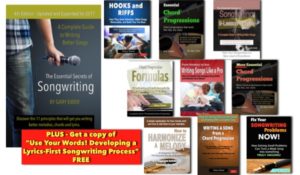Improvisation is an important part of most musician’s songwriting process. You sit at a keyboard, or set up some loops, or start strumming your guitar, and you generate ideas spontaneously. It’s fun to work this way.
And I suppose you might say that the stronger your musical imagination, the more likely you’ll hit upon hook-like ideas that stick. Once you’ve got those hooks working, it becomes a bit easier to figure out what might lead up to it, and then you’ve got the makings of a song.
 If you’re trying to make lyric-writing the first step when you write songs, give this eBook a read: “Use Your Words! Developing a Lyrics-First Songwriting Process.” It shows 3 ways you can get the songwriting process started with lyrics. Right now, it’s FREE with your purchase of “The Essential Secrets of Songwriting” eBook Bundle.
If you’re trying to make lyric-writing the first step when you write songs, give this eBook a read: “Use Your Words! Developing a Lyrics-First Songwriting Process.” It shows 3 ways you can get the songwriting process started with lyrics. Right now, it’s FREE with your purchase of “The Essential Secrets of Songwriting” eBook Bundle.
The same can be said for writing a good lyric. You get a catchy rhythm and chord progression, a few snippets of melody, and suddenly you find that bits and fragments of words start to assemble themselves. Guitarist-songwriter Mike Rutherford mentions that when Genesis was writing their 1986 hit song “Invisible Touch,” it started with a rhythm on a drum machine, with Rutherford adding chords. Phil Collins spontaneously sang, “She seems to have an invisible touch…”, and the song was well on its way.
Once he had that line, of course, the rest of the lyric, at least with regard to its meaning, started to fall into place.
I’m sure that Genesis still had some work to do to make the lyric work with everything else. As you work out a lyric for your song, one of the biggest challenges will be to have the words fit naturally with the melody.
The biggest issue? That the natural pulse of the words fits the natural pulse of the melody. Music is typically arranged in a series of strong beats and weak beats. Most English words have strongly accented syllables mixed in with less-accented ones:
- “be-SIDE”
- “LOV-ing-ly”
- “in-VIS-i-ble”
The same can be said for groups of words:
- “NOW you’re just some-BOD-y that I USED to know…”
Placing those words together with melodies means making sure that the rhythm of the melody honours the rhythm of the words.
One of the best techniques for ensuring that your lyric sounds natural and effortless is to speak your lyric to the rhythm of your melody.
Ignoring the pitches for the moment, take a favourite lyric and read it, using the rhythms you’re familiar with:
Hello, it’s me
I was wondering if after all these years you’d like to meet
To go over everything
They say that time’s supposed to heal ya
But I ain’t done much healing
(“Hello” – Adele Adkins, Greg Kurstin)
Notice how everything seems to fit in and around the beats in a natural sort of way. No words are forced into a position against the strong beat-weak beat arrangement dictated by the time signature. It all feels effortless.
That’s a crucial part of having a lyric sound right. Getting that to work sometimes means adding words, subtracting words, or finding an entirely new way to say the same thing. When all is said and done, a good lyric should sound like a partner along with pitch and rhythm.
So no matter how successful your improvisation process is, and regardless of how much of your lyric seemed to happen spontaneously, it’s worth the time to try that process of speaking a lyric without the melody. That step will reveal any awkward rhythmic moments, and you’ll wind up with something that’s a lot easier to sing, and a lot easier for the audience to remember.
 Written by Gary Ewer. Follow Gary on Twitter.
Written by Gary Ewer. Follow Gary on Twitter.
 Thousands of songwriters are using The Essential Secrets of Songwriting eBooks to straighten out their songwriting problems. Have you been spending years just reinforcing errors? Sort out your technique! Get today’s free deal!
Thousands of songwriters are using The Essential Secrets of Songwriting eBooks to straighten out their songwriting problems. Have you been spending years just reinforcing errors? Sort out your technique! Get today’s free deal!











The method of using a preset Rhythm when composing via a
Drum box or Synth is a must for me
Too often I hear DEMOS of new songs where the Writer/s have got
it completely wrong; Many potentially good ideas are doomed by the wrong
Tempo or a Singer who’s voice is not up to the job in hand , and its not
always something we get right every time , realising our mistakes and
rectifying them is all part of the work in hand